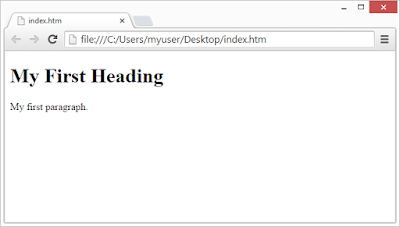What is HTML?
HTML is a markup language for describing web documents (web pages).
- HTML stands for Hyper Text Markup Language
- A markup language is a set of markup tags
- HTML documents are described by HTML tags
- Each HTML tag describes different document content
A small HTML Document
<!DOCTYPE html>
<html>
<head>
<title>Page Title</title>
</head>
<body>
<h1>My First Heading</h1>
<p>My first paragraph.</p>
</body>
</html>
Example Explained
- The DOCTYPE declaration defines the document type to be HTML
- The text between <html> and </html> describes an HTML document
- The text between <head> and </head> provides information about the document
- The text between <title> and </title> provides a title for the document
- The text between <body> and </body> describes the visible page content
- The text between <h1> and </h1> describes a heading
- The text between <p> and </p> describes a paragraph
Using this description, a web browser can display a document with a heading and a paragraph.
HTML tags
HTML tags are keywords (tag names) surrounded by angle brackets:
<tagname>content</tagname>
- HTML tags normally come in pairs like <p> and </p>
- The first tag in a pair is the start tag, the second tag is the end tag
- The end tag is written like the start tag, but with a slash before the tag name
Web Browser
The purpose of a web browser (Chrome, IE, Firefox, Safari) is to read HTML documents & display them.
The browser does not display the HTML tags, but makes use of them to select how to display the document:
 |
| Introduction Of HTML5 |
The <!DOCTYPE> Declaration
The <!DOCTYPE> declaration helps the browser to display a web page correctly.
There's different document types on the net.
To display a document correctly, the browser must know both type & version.
The doctype declaration is not case sensitive. All cases are acceptable:
<!DOCTYPE html>
<!DOCTYPE HTML>
<!doctype html>
<!Doctype Html>
HTML VERIONS
Since the early days of the web, there have been many versions of HTML:
Version Year
HTML 1991
HTML 2.0 1995
HTML 3.2 1997
HTML 4.01 1999
XHTML 2000
HTML5 2014













